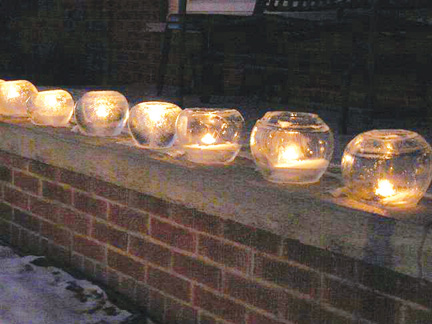Doing It Yourself – How To Make An Ice Luminary
By Deborah Locke, Information Officer, Minnesota DNR
You ventured out on a candlelight walk in a state park and now want to make your own luminary. Linda Radimecky, Afton State Park naturalist, has created and displayed dozens and dozens of luminaries over the years, and offers two words to live by when it comes to creating ice candle holders: Timing. Temperature.
Timing, because the ideal luminary freezes nearly all the way through, with just enough water poured off the center to hold a light. Temperature because freeze times vary. Usually Minnesotans can count on extreme cold in January, but not always.
The Afton State Park staff uses five-gallon buckets to make the luminaries used on candlelight walks. Check online and you will see many methods of creating these seasonal beauties, from balloons filled with water and frozen, to the use of a bundt cake pan (Martha Stewart’s invention.) It takes a certain finesse to make these, but when they are mastered, luminaries bring a lovely flicker to a winter evening.
The Afton State Park luminaries usually take 24 hours to freeze, and often an additional eight hours, Radimecky said. Here is how they are made:
- Fill the bucket until it is an inch from the top of the bucket.
- Set the bucket outside on a flat, preferably insulated surface; the water freezes from the top down and the outside to the inside. It will take at least 24 hours to freeze. Ideally, anything below 15 degrees should do it.
- Bring the bucket inside, tip it over in a large sink and run warm water on the outside. It will pop out with the top of the luminary facing up. Use a screwdriver and hammer to tap a hole into what was the bottom of the ice mass and pour out any water that didn’t freeze solid. That will create a cavern for a candle or tea light. The ice may have frozen solid and it will take longer to create the light cavern.
Above is the old-fashioned and probably least expensive way to make a luminary. Online you’ll see instructions for placing a smaller one-gallon bucket on the inside of the five-gallon bucket, which creates a space for adding the candle or light. The smaller container is weighted with rocks and is duct-taped into place before water is added to the larger container. Sometimes greenery and berries are stuffed down the wall of the larger container, which freeze into place and make a really beautiful luminary.
Keep an eye on your luminary in the event a raccoon or larger animal decide to knock it over. Your best and safest light source is a LED tea light, which can be found inexpensively at any dollar store. Don’t use a glass container, which will break when it is frozen. Also, wear warm gloves under rubber gloves when you are working with the ice.
Again, trial and error will lead to what could be your neighborhood’s most beautifully lit yard. Meanwhile, if you’ve never seen a luminary, check out your Minnesota state parks. They are all over the place.














